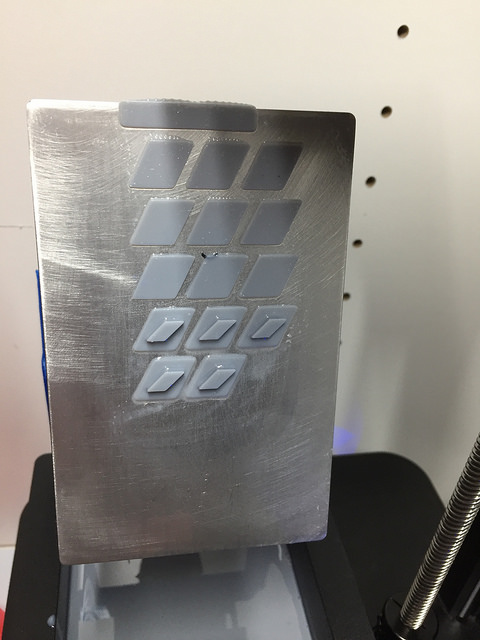You are not logged in.
- Topics: Active | Unanswered
Pages: 1
#1 2017-07-03 06:24:01
- fsamir
- Member
- Registered: 2017-07-03
- Posts: 2
How to read the Calibration Plate?
Hi makers,
how to interpret the Calibration plate?
I understand it prints at different cure times, to help determining the best cure times for a resin, but how do I determine which block was printed at a certain temperature?
Offline
#2 2017-07-03 06:37:59
- 1125lbs
- Member
- Registered: 2017-03-15
- Posts: 81
Re: How to read the Calibration Plate?
do you use lamp or led on your system?
Temp will affect viscosity, which by the way influence somehow in kinects change, if you do some search about temp, you will see at normal conditions that temperature will not have significant change on resin kinects, if should take account primary the energy dose and dynamics.
Offline
#3 2017-07-03 07:04:08
- fsamir
- Member
- Registered: 2017-07-03
- Posts: 2
Re: How to read the Calibration Plate?
Sorry, my bad. Where I wrote "temperature" should read "cure time".
I use a Wanhao D7, LED based printer and I am trying to determine the ideal cure time for a resin.
Basically, I want to know what was the cure time for the parts at the bottom of the picture.

Last edited by fsamir (2017-07-03 07:07:47)
Offline
#4 2017-07-03 15:03:37
- laopa
- Member
- Registered: 2017-03-01
- Posts: 9
Re: How to read the Calibration Plate?
Hi
Me i use this function when i test new resin, generaly i will print smaller base at 2mm over 1 mm thick and then very narrow wall at 0.5mm width. If you look at the bottom of your picture, i have the same but 10 times smaller. After that i will place different timing from 4s to 12 s.
After generate the plate i will look at the layer display and count the number of pad per raw, this to adjust my timing setup again to get one timing per raw. In clear, i have 6 pads per raw, so i will write the timing like this 4,4,4,4,4,4,5,5,5,5,5,5,6,6,6,6,6,6,.......
Re generate and launch the print.
When finish, i will not clean my plate yet, and with the finger, will see what raw is the softer one, if it bent, move left or right.
This give me the target curing time for my prints. If my print have very large surfaces, i will increase 0.5 to 1 second my target. If my print have thin walls, thin supports, then i will stay at target time. If you want print proof faillures, then target plus 1 or 2s.
Remember, soft curing will give you print not stable, so deformed print. hard curring give you good print and stable. Over cure will break you vat faster.
And i forgot, the top print on your picture is used for calibration. Measure x and y.
Wish can help.
Last edited by laopa (2017-07-03 15:04:48)
Offline
#5 2017-09-27 16:06:44
- Belal
- Member
- Registered: 2017-09-10
- Posts: 27
Re: How to read the Calibration Plate?
Hi
Me i use this function when i test new resin, generaly i will print smaller base at 2mm over 1 mm thick and then very narrow wall at 0.5mm width. If you look at the bottom of your picture, i have the same but 10 times smaller. After that i will place different timing from 4s to 12 s.
After generate the plate i will look at the layer display and count the number of pad per raw, this to adjust my timing setup again to get one timing per raw. In clear, i have 6 pads per raw, so i will write the timing like this 4,4,4,4,4,4,5,5,5,5,5,5,6,6,6,6,6,6,.......Re generate and launch the print.
When finish, i will not clean my plate yet, and with the finger, will see what raw is the softer one, if it bent, move left or right.
This give me the target curing time for my prints. If my print have very large surfaces, i will increase 0.5 to 1 second my target. If my print have thin walls, thin supports, then i will stay at target time. If you want print proof faillures, then target plus 1 or 2s.Remember, soft curing will give you print not stable, so deformed print. hard curring give you good print and stable. Over cure will break you vat faster.
And I forgot, the top print on your picture is used for calibration. Measure x and y.
Wish can help.
I don't understand what is the purpose of the cube measurement?
and what curing time for it, it appears and disappears with a sequence that I can't understand!
Also, how it deals with burning layers, is all have the same curing time or what?
Offline
#6 2017-11-22 15:15:56
- Doug
- Member
- Registered: 2017-08-11
- Posts: 72
Re: How to read the Calibration Plate?
Question
The calibration plate uses the mask?
Offline
#7 2017-11-23 06:47:51
- Shahin
- Administrator
- Registered: 2016-02-17
- Posts: 1,834
Re: How to read the Calibration Plate?
No, it ignores mask. Probably would be better if we have it applied or make it optional.
Offline
Pages: 1